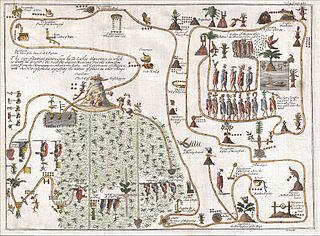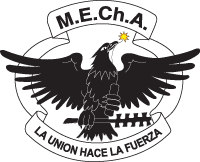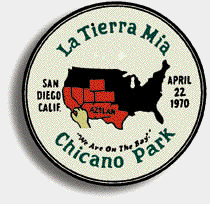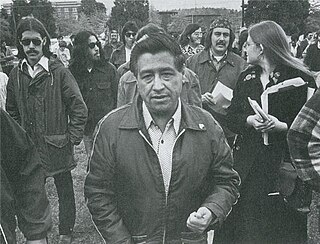Related Research Articles

Chicano or Chicana is an ethnic identity for Mexican Americans who have a non-Anglo self-image, embracing their Mexican Native ancestry. Chicano was originally a classist and racist slur used toward low-income Mexicans that was reclaimed in the 1940s among youth who belonged to the Pachuco and Pachuca subculture. In the 1960s, Chicano was widely reclaimed in the building of a movement toward political empowerment, ethnic solidarity, and pride in being of indigenous descent. Chicano developed its own meaning separate from Mexican American identity. Youth in barrios rejected cultural assimilation into whiteness and embraced their own identity and worldview as a form of empowerment and resistance. The community forged an independent political and cultural movement, sometimes working alongside the Black power movement.

“Aztlán” is the ancestral home of the Aztec peoples. Astekah is the Nahuatl word for "people from Aztlan". Aztlan is mentioned in several ethnohistorical sources dating from the colonial period, and while they each cite varying lists of the different tribal groups who participated in the migration from Aztlan to central Mexico, the Mexica who went on to found Mexico-Tenochtitlan are mentioned in all of the accounts.

M.E.Ch.A. is a US-based organization that seeks to promote Chicano unity and empowerment through political action. The acronym of the organization's name is the Chicano word mecha, which is the Chicano pronunciation of the English word match and therefore symbolic of a fire or spark; mecha in Spanish means fuse or wick. The motto of MEChA is 'La Union Hace La Fuerza'.
Bronze race is a term used since the early 20th century by Hispanic American writers of the indigenista and americanista schools to refer to the mestizo population that arose in the Americas with the arrival of Latin European settlers and their intermingling with the New World's Amerindian peoples.

El Plan de Santa Bárbara: A Chicano Plan for Higher Education is a 155-page document, which was written in 1969 by the Chicano Coordinating Council on Higher Education. Drafted at the University of California Santa Barbara, it is a blueprint for the inception of Chicana/o studies programs in colleges and universities throughout the US. The Chicano Coordinating Council expresses political mobilization to be dependent upon political consciousness, thus the institution of education is targeted as the platform to raise political conscious amongst Chicanos and spur higher learning to political action. The Plan proposes a curriculum in Chicano studies, the role of community control in Chicano education and the necessity of Chicano political independence. The document was a framework for educational and curriculum goals for the Chicano movements within the institution of education, while being the foundation for the Chicano student group Movimiento Estudiantil Chicano de Aztlán (MEChA).

The Plan Espiritual de Aztlán was a pro-indigenist manifesto advocating Chicano nationalism and self-determination for Mexican Americans. It was adopted by the First National Chicano Liberation Youth Conference, a March 1969 convention hosted by Rodolfo Gonzales's Crusade for Justice in Denver, Colorado.

The Reconquista ("reconquest") is a term to describe an irredentist vision by different individuals, groups, and/or nations that the Southwestern United States should be politically or culturally returned to Mexico. Known as advocating a Greater Mexico, such opinions are often formed on the basis that those territories were claimed by Spain for centuries and then by Mexico from 1821 until they were annexed by the United States during the Texas Annexation (1845) and the Mexican Cession (1848) because of the Mexican–American War.

The Brown Berets is a pro-Chicano paramilitary organization that emerged during the Chicano Movement in the late 1960s. David Sanchez and Carlos Montes co-founded the group modeled after the Black Panther Party. The Brown Berets was part of the Third World Liberation Front. It worked for educational reform, farmworkers' rights, and against police brutality and the Vietnam War. It also sought to separate the American Southwest from the control of the United States government.

Chicano Park is a 32,000 square meter park located beneath the San Diego–Coronado Bridge in Barrio Logan, a predominantly Chicano or Mexican American and Mexican-migrant community in central San Diego, California. The park is home to the country's largest collection of outdoor murals, as well as various sculptures, earthworks, and an architectural piece dedicated to the cultural heritage of the community. Because of the magnitude and historical significance of the murals, the park was designated an official historic site by the San Diego Historical Site Board in 1980, and its murals were officially recognized as public art by the San Diego Public Advisory Board in 1987. The park was listed on the National Register of Historic Places in 2013 owing to its association with the Chicano Movement, and was designated a National Historic Landmark in 2016. Chicano Park, like Berkeley's People's Park, was the result of a militant people's land takeover. Every year on April 22, the community celebrates the anniversary of the park's takeover with a celebration called Chicano Park Day.

Rodolfo "Corky" Gonzales was a Mexican-American boxer, poet, political organizer, and activist. He was one of many leaders for the Crusade for Justice in Denver, Colorado. The Crusade for Justice was an urban rights and Chicano cultural urban movement during the 1960s focusing on social, political, and economic justice for Chicanos. Gonzales convened the first-ever Chicano Youth Liberation Conference in 1968, which was poorly attended due to timing and weather conditions. He tried again in March 1969, and established what is commonly known as the First Chicano Youth Liberation Conference. This conference was attended by many future Chicano activists and artists. It also birthed the Plan Espiritual de Aztlán, a pro-indigenist manifesto advocating revolutionary Chicano nationalism and self-determination for all Chicanos. Through the Crusade for Justice, Gonzales organized the Mexican American people of Denver to fight for their cultural, political, and economic rights, leaving his mark on history. He was honored with a Google Doodle in continued celebration of National Hispanic Heritage Month in the United States on 30 September 2021.

Chicanismo emerged as the cultural consciousness behind the Chicano Movement. The central aspect of Chicanismo is the identification of Chicanos with their Indigenous American roots to create an affinity with the notion that they are native to the land rather than immigrants. Chicanismo brought a new sense of nationalism for Chicanos that extended the notion of family to all Chicano people. Barrios, or working-class neighborhoods, became the cultural hubs for the people. It created a symbolic connection to the ancestral ties of Mesoamerica and the Nahuatl language through the situating of Aztlán, the ancestral home of the Aztecs, in the southwestern United States. Chicanismo also rejected Americanization and assimilation as a form of cultural destruction of the Chicano people, fostering notions of Brown Pride. Xicanisma has been referred to as an extension of Chicanismo.

The Chicano Movement, also referred to as El Movimiento, was a social and political movement in the United States that worked to embrace a Chicano/a identity and worldview that combated structural racism, encouraged cultural revitalization, and achieved community empowerment by rejecting assimilation. Chicanos also expressed solidarity and defined their culture through the development of Chicano art during El Movimiento, and stood firm in preserving their religion.

Chicano/a studies, also known as Chican@ studies, originates from the Chicano Movement of the late 1960s and 1970s, and is the study of the Chicana/o and Latina/o experience. Chican@ studies draws upon a variety of fields, including history, sociology, the arts, and Chican@ literature. The area of studies additionally emphasizes the importance of Chican@ educational materials taught by Chican@ educators for Chican@ students.

I Am Joaquin, by Rodolfo "Corky" Gonzales and translated by Juanita Dominguez, is a famous epic poem associated with the Chicano movement of the 1960s in the United States. In I am Joaquin, Joaquin speaks of the struggles that the Chicano people have faced in trying to achieve economic justice and equal rights in the U.S., as well as to find an identity of being part of a hybrid mestizo society. He promises that his culture will survive if all Chicano people stand proud and demand acceptance.
Las Adelitas de Aztlán was a short-lived Mexican American female civil rights organization that was created by Gloria Arellanes and Gracie and Hilda Reyes in 1970. Gloria Arellanes and Gracie and Hilda Reyes were all former members of the Brown Berets, another Mexican American Civil rights organization that had operated concurrently during the 1960s and 1970s in the California area. The founders left the Brown Berets due to enlarging gender discrepancies and disagreements that caused much alienation amongst their female members. The Las Adelitas De Aztlan advocated for Mexican-American Civil rights, better conditions for workers, protested police brutality and advocated for women's rights for the Latino community. The name of the organization was a tribute to Mexican female soldiers or soldaderas that fought during the Mexican Revolution of the early twentieth century.

Chicana literature is a form of literature that has emerged from the Chicana Feminist movement. It aims to redefine Chicana archetypes in an effort to provide positive models for Chicanas. Chicana writers redefine their relationships with what Gloria Anzaldúa has called "Las Tres Madres" of Mexican culture by depicting them as feminist sources of strength and compassion.

The Chicano Art Movement represents groundbreaking movements by Mexican-American artists to establish a unique artistic identity in the United States. Much of the art and the artists creating Chicano Art were heavily influenced by Chicano Movement which began in the 1960s.
This is a Mexican American bibliography. This list consists of books, and journal articles, about Mexican Americans, Chicanos, and their history and culture. The list includes works of literature whose subject matter is significantly about Mexican Americans and the Chicano/a experience. This list does not include works by Mexican American writers which do not address the topic, such as science texts by Mexican American writers.

Mexican-American folklore refers to the tales and history of Chicano people who live in the United States.

A Mexican American is a resident of the United States who is of Mexican descent. Mexican American-related topics include the following:
References
- Chávez, Ernesto. "Mi raza primero!" (My people first!): nationalism, identity, and insurgency in the Chicano movement in Los Angeles, 1966–1978 Berkeley: University of California Press, 2002. ISBN 0-520-23018-3.